Find References To Draw A Head From Any Angle!
Find References to Draw a Head from Any Angle!
The web application returns images of heads at certain angles. Super helpful resource for figuring out how to draw a head at a tricky angle


With tags for emotions, glasses, different ages, and more!

More Posts from Quandrixing and Others

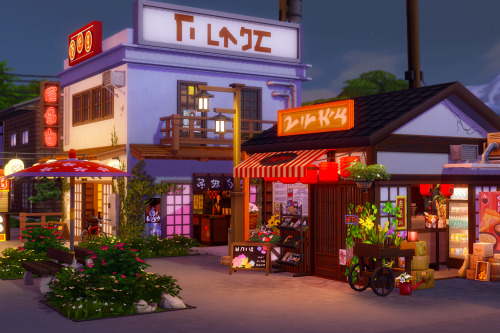
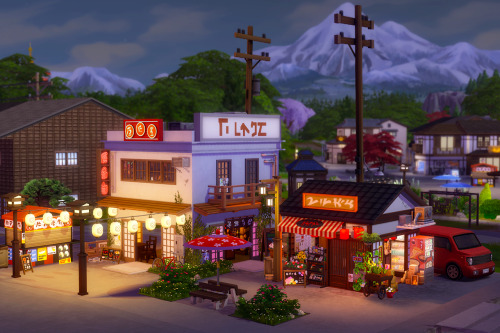
6-4-1 hanamigawa, expanded
bar + flower shop (yep lol)
no cc
most eps required
dl: gallery: myshunosun / tray files
@maxismatchccworld @s4-builds @simblrcollective

old guard
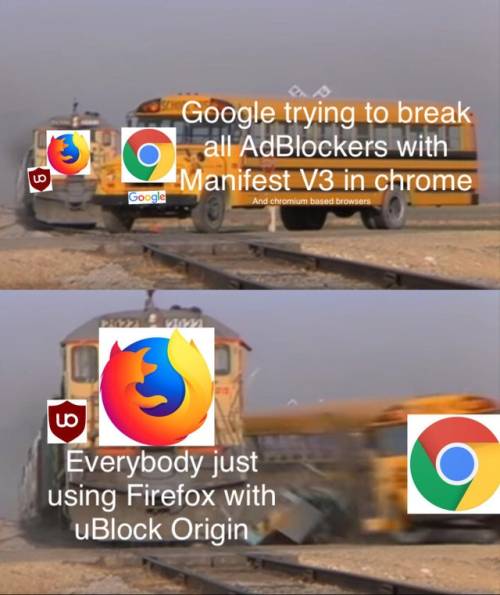
My sister rang me today.
Ever since she was six, she's had pain in her legs, which turns into pain in her hips and back for stretches of time. She's tried for years to get a diagnosis, with absolutely no joy. As a kid they thought she had collapsed arches in her feet; then it became clear her feet were fine, but something was wrong with her tendons; and then in her 20s they just shrugged it off with a "We'll never know probably" and that was that. She keeps on top of it with daily yoga, generally, though flare ups happen periodically. If she has to pause the yoga for some reason, she fairly rapidly regresses. Currently she has plantar fascitis again, which has halted everything once more, so right now she's back into a pain slump.
Anyway, she called me today while going from Doctors to pharmacy to get the codeine they've prescribed her for it.
"I think one of my yoga moves to help the fascitis might have exacerbated the legs," she said. "Trouble is, there's never been a diagnosis. I just have to trial and error what might help."
... And I had one of those lightbulb moments, you know? My brain suddenly went "Wait hang on, this is very familiar isn't it?" and rang the bells of memory.
"Did they ever test you for fibromyalgia?" I said.
They had not. It's never been suggested, even. My sister said she'd look up the symptoms and see if it chimed, and rang off.
Fifteen minutes later, she calls back.
Turns out she got to the pharmacy and gave them the prescription. While waiting, she googled fibromyalgia symptoms and found the NHS website.
"It was like someone had written a profile of me," she tells me on the phone. "Like, spookily, scarily accurate to me, right down to the temperature regulation bit. It felt like a practical joke."
And of course, as she stood there in the pharmacy, suddenly staring at the age of forty at the apparent answer she's been trying to get since she was six years old, she burst into tears.
"Oh no!" Said the pharmacist, hurdling the counter in a single leap and scattering the queue (I am exaggerating for humorous affectation.) "Quickly! Come into our little exam room, we'll get you tissues and water!"
My sister was duly ensconced into a Safe Place, and encouraged to cry it out. It took several hiccuping minutes, but finally, she managed to calm down and get back to an Extremely Watery Smile.
"Do you want to talk about it?" the pharmacist asked sympathetically.
"It's just..." my sister said, overwhelmed and searching for words. "My whole life I've been in pain, and they've never found why..."
"Ah," said the pharmacist thoughtfully. "Have you explored fibromyalgia?"
...
"TWICE IN ONE DAY," my sister yells on the phone to me later. "HOW THE HELL HAVE TWO SEPARATE PEOPLE ON THE SAME DAY FINALLY GIVEN ME THE ANSWER, AND NEITHER OF YOU IS A DOCTOR"
Anyway she has a doctor's appointment for tomorrow to discuss it, so we'll see
Throwback thursday to when I was like 12 and I was putting out new writing DAILY...... Like entire Chapters of my then-current wips just, over an afternoon. What the fuck was I on
I feel like I should make a post about this because it’s not something that’s very well-known, and that Americans in particular may need to know about given the uncertain state of our healthcare system at the moment. I’ve wanted to write this out for a while, It’s kind of a long post, so sorry about that!
If you have an emergency and have to go to the hospital, you’ll owe the hospital a lot of money. (I got into a car wreck and broke my ankle and my arm. My hospital bill was around $20,000)
You’ll also owe the ambulance provider, if you need one. (My ambulance bill was about $800)
You may get separate bills from the anesthesiologist or surgeon. (My anesthesiologist bill was $1,700)
You may need follow-up appointments. (My orthopedic surgeon billed me for the appointments and his surgery together and it was about $1,000)
You’ve also got to pay for medical equipment you need afterward, like crutches or a walking boot. (Mine cost about $75)
Altogether, I ended up with almost $24,000 in medical debt from one car accident. That’s a really scary number for someone like me who makes $10/hr at a 12 hour a week job.
I got my debt down to $1075 by making some phone calls and submitting some paperwork.
The first thing I did was contact the hospital. They don’t make it easy to find, but many hospitals (perhaps most hospitals?) have financial assistance programs for people who can’t afford medical bills. I don’t make a lot of money, and I have bills to pay, so they were able to help me. I called the billing department and asked if they had any assistance programs for low income people who can’t pay their bills. I had to call multiple times, and I got transferred in circles by people who didn’t know what I was talking about. Finally, I got an appointment with someone in “Eligibility Services” (I don’t know what other hospitals call it, if it’s something different). I had to bring my pay stubs and copies of all of my bills. When I got to the hospital for the appointment, nobody knew what I was talking about so I had to wander a little to find where I needed to go. I spoke with the guy in Eligibility Services, and I waited for a decision on how much of the bill they would forgive. A month later, I got a call telling me it was totally forgiven.
I did the same thing for my ambulance bill and my anesthesiologist, but the process was a LOT easier. I just had to mail some paperwork and it was totally forgiven.
I didn’t bother with the medical equipment suppliers, since the bills came from separate companies and I didn’t feel like going through the process twice for $75. I was assured at the hospital that they had similar programs for debt forgiveness, so I could have probably avoided paying that too.
The only thing I couldn’t get taken care of was the surgeon/follow-up appointment cost, but they were able to put me on a no-interest payment plan.
Medical debt is scary because it’s something that can come from stuff that’s already really scary. I didn’t need the burden of $24,000 in debt on top of trying to get around on a crutch with a broken arm (it’s not easy, believe me!).. but I can’t imagine what it would be like with a bigger debt or a more severe medical emergency. I see lots of people in even worse trouble than I was in, both financially and medically. Please know that there are options for you when that GoFundMe doesn’t do enough. Even if your income is higher than mine, it’s worth a shot even for partial debt forgiveness.
Words for Skin Tone | How to Describe Skin Color
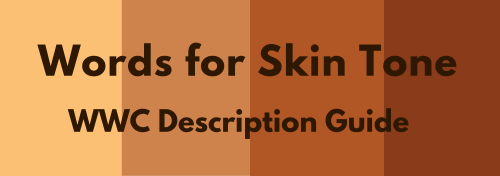
We discussed the issues describing People of Color by means of food in Part I of this guide, which brought rise to even more questions, mostly along the lines of “So, if food’s not an option, what can I use?” Well, I was just getting to that!
This final portion focuses on describing skin tone, with photo and passage examples provided throughout. I hope to cover everything from the use of straight-forward description to the more creatively-inclined, keeping in mind the questions we’ve received on this topic.
Standard Description
Basic Colors

Pictured above: Black, Brown, Beige, White, Pink.
“She had brown skin.”
This is a perfectly fine description that, while not providing the most detail, works well and will never become cliché.
Describing characters’ skin as simply brown or beige works on its own, though it’s not particularly telling just from the range in brown alone.
Complex Colors
These are more rarely used words that actually “mean” their color. Some of these have multiple meanings, so you’ll want to look into those to determine what other associations a word might have.

Pictured above: Umber, Sepia, Ochre, Russet, Terra-cotta, Gold, Tawny, Taupe, Khaki, Fawn.
Complex colors work well alone, though often pair well with a basic color in regards to narrowing down shade/tone.
For example: Golden brown, russet brown, tawny beige…
As some of these are on the “rare” side, sliding in a definition of the word within the sentence itself may help readers who are unfamiliar with the term visualize the color without seeking a dictionary.
“He was tall and slim, his skin a russet, reddish-brown.”
Comparisons to familiar colors or visuals are also helpful:
“His skin was an ochre color, much like the mellow-brown light that bathed the forest.”
Modifiers
Modifiers, often adjectives, make partial changes to a word.The following words are descriptors in reference to skin tone.
Dark - Deep - Rich - Cool
Warm - Medium - Tan
Fair - Light - Pale
Rich Black, Dark brown, Warm beige, Pale pink…
If you’re looking to get more specific than “brown,” modifiers narrow down shade further.
Keep in mind that these modifiers are not exactly colors.
As an already brown-skinned person, I get tan from a lot of sun and resultingly become a darker, deeper brown. I turn a pale, more yellow-brown in the winter.
While best used in combination with a color, I suppose words like “tan” “fair” and “light” do work alone; just note that tan is less likely to be taken for “naturally tan” and much more likely a tanned White person.
Calling someone “dark” as description on its own is offensive to some and also ambiguous. (See: Describing Skin as Dark)
Undertones
Undertones are the colors beneath the skin, seeing as skin isn’t just one even color but has more subdued tones within the dominating palette.
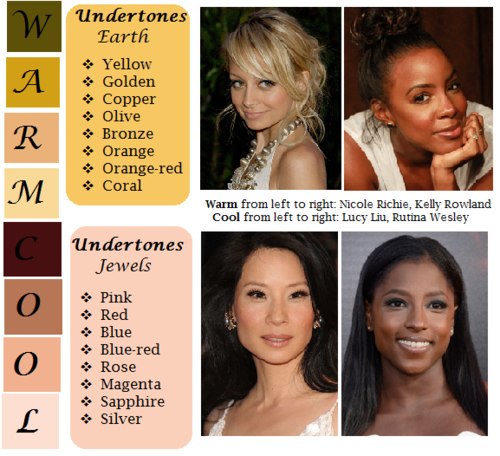
pictured above: warm / earth undertones: yellow, golden, copper, olive, bronze, orange, orange-red, coral | cool / jewel undertones: pink, red, blue, blue-red, rose, magenta, sapphire, silver.
Mentioning the undertones within a character’s skin is an even more precise way to denote skin tone.
As shown, there’s a difference between say, brown skin with warm orange-red undertones (Kelly Rowland) and brown skin with cool, jewel undertones (Rutina Wesley).
“A dazzling smile revealed the bronze glow at her cheeks.”
“He always looked as if he’d ran a mile, a constant tinge of pink under his tawny skin.”
Standard Description Passage
“Farah’s skin, always fawn, had burned and freckled under the summer’s sun. Even at the cusp of autumn, an uneven tan clung to her skin like burrs. So unlike the smooth, red-brown ochre of her mother, which the sun had richened to a blessing.”
-From my story “Where Summer Ends” featured in Strange Little Girls
Here the state of skin also gives insight on character.
Note my use of “fawn” in regards to multiple meaning and association. While fawn is a color, it’s also a small, timid deer, which describes this very traumatized character of mine perfectly.
Though I use standard descriptions of skin tone more in my writing, at the same time I’m no stranger to creative descriptions, and do enjoy the occasional artsy detail of a character.
Creative Description
Whether compared to night-cast rivers or day’s first light…I actually enjoy seeing Characters of Colors dressed in artful detail.
I’ve read loads of descriptions in my day of white characters and their “smooth rose-tinged ivory skin”, while the PoC, if there, are reduced to something from a candy bowl or a Starbucks drink, so to actually read of PoC described in lavish detail can be somewhat of a treat.
Still, be mindful when you get creative with your character descriptions. Too many frills can become purple-prose-like, so do what feels right for your writing when and where. Not every character or scene warrants a creative description, either. Especially if they’re not even a secondary character.
Using a combination of color descriptions from standard to creative is probably a better method than straight creative. But again, do what’s good for your tale.
Natural Settings - Sky

Pictured above: Harvest Moon -Twilight, Fall/Autumn Leaves, Clay, Desert/Sahara, Sunlight - Sunrise - Sunset - Afterglow - Dawn- Day- Daybreak, Field - Prairie - Wheat, Mountain/Cliff, Beach/Sand/Straw/Hay.
Now before you run off to compare your heroine’s skin to the harvest moon or a cliff side, think about the associations to your words.
When I think cliff, I think of jagged, perilous, rough. I hear sand and picture grainy, yet smooth. Calm. mellow.
So consider your character and what you see fit to compare them to.
Also consider whose perspective you’re describing them from. Someone describing a person they revere or admire may have a more pleasant, loftier description than someone who can’t stand the person.
“Her face was like the fire-gold glow of dawn, lifting my gaze, drawing me in.”
“She had a sandy complexion, smooth and tawny.”
Even creative descriptions tend to draw help from your standard words.
Flowers
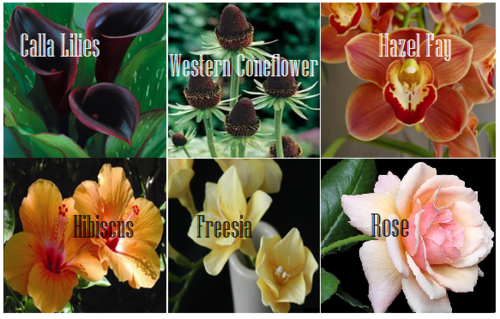
Pictured above: Calla lilies, Western Coneflower, Hazel Fay, Hibiscus, Freesia, Rose
It was a bit difficult to find flowers to my liking that didn’t have a 20 character name or wasn’t called something like “chocolate silk” so these are the finalists.
You’ll definitely want to avoid purple-prose here.
Also be aware of flowers that most might’ve never heard of. Roses are easy, as most know the look and coloring(s) of this plant. But Western coneflowers? Calla lilies? Maybe not so much.
“He entered the cottage in a huff, cheeks a blushing brown like the flowers Nana planted right under my window. Hazel Fay she called them, was it?”
Assorted Plants & Nature

Pictured above: Cattails, Seashell, Driftwood, Pinecone, Acorn, Amber
These ones are kinda odd. Perhaps because I’ve never seen these in comparison to skin tone, With the exception of amber.
At least they’re common enough that most may have an idea what you’re talking about at the mention of “pinecone.“
I suggest reading out your sentences aloud to get a better feel of how it’ll sounds.
"Auburn hair swept past pointed ears, set around a face like an acorn both in shape and shade.”
I pictured some tree-dwelling being or person from a fantasy world in this example, which makes the comparison more appropriate.
I don’t suggest using a comparison just “cuz you can” but actually being thoughtful about what you’re comparing your character to and how it applies to your character and/or setting.
Wood

Pictured above: Mahogany, Walnut, Chestnut, Golden Oak, Ash
Wood can be an iffy description for skin tone. Not only due to several of them having “foody” terminology within their names, but again, associations.
Some people would prefer not to compare/be compared to wood at all, so get opinions, try it aloud, and make sure it’s appropriate to the character if you do use it.
“The old warlock’s skin was a deep shade of mahogany, his stare serious and firm as it held mine.”
Metals

Pictured above: Platinum, Copper, Brass, Gold, Bronze
Copper skin, brass-colored skin, golden skin…
I’ve even heard variations of these used before by comparison to an object of the same properties/coloring, such as penny for copper.
These also work well with modifiers.
“The dress of fine white silks popped against the deep bronze of her skin.”
Gemstones - Minerals
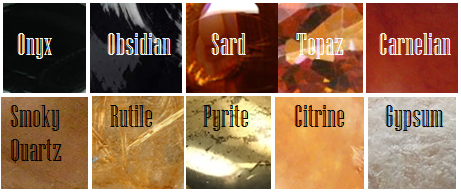
Pictured above: Onyx, Obsidian, Sard, Topaz, Carnelian, Smoky Quartz, Rutile, Pyrite, Citrine, Gypsum
These are trickier to use. As with some complex colors, the writer will have to get us to understand what most of these look like.
If you use these, or any more rare description, consider if it actually “fits” the book or scene.
Even if you’re able to get us to picture what “rutile” looks like, why are you using this description as opposed to something else? Have that answer for yourself.
“His skin reminded her of the topaz ring her father wore at his finger, a gleaming stone of brown, mellow facades.”
Physical Description
Physical character description can be more than skin tone.
Show us hair, eyes, noses, mouth, hands…body posture, body shape, skin texture… though not necessarily all of those nor at once.
Describing features also helps indicate race, especially if your character has some traits common within the race they are, such as afro hair to a Black character.
How comprehensive you decide to get is up to you. I wouldn’t overdo it and get specific to every mole and birthmark. Noting defining characteristics is good, though, like slightly spaced front teeth, curls that stay flopping in their face, hands freckled with sunspots…
General Tips
Indicate Race Early: I suggest indicators of race be made at the earliest convenience within the writing, with more hints threaded throughout here and there.
Get Creative On Your Own: Obviously, I couldn’t cover every proper color or comparison in which has been “approved” to use for your characters’ skin color, so it’s up to you to use discretion when seeking other ways and shades to describe skin tone.
Skin Color May Not Be Enough: Describing skin tone isn’t always enough to indicate someone’s ethnicity. As timeless cases with readers equating brown to “dark white” or something, more indicators of race may be needed.
Describe White characters and PoC Alike: You should describe the race and/or skin tone of your white characters just as you do your Characters of Color. If you don’t, you risk implying that White is the default human being and PoC are the “Other”).
PSA: Don’t use “Colored.” Based on some asks we’ve received using this word, I’d like to say that unless you or your character is a racist grandmama from the 1960s, do not call People of Color “colored” please.
Not Sure Where to Start? You really can’t go wrong using basic colors for your skin descriptions. It’s actually what many people prefer and works best for most writing. Personally, I tend to describe my characters using a combo of basic colors + modifiers, with mentions of undertones at times. I do like to veer into more creative descriptions on occasion.
Want some alternatives to “skin” or “skin color”? Try: Appearance, blend, blush, cast, coloring, complexion, flush, glow, hue, overtone, palette, pigmentation, rinse, shade, sheen, spectrum, tinge, tint, tone, undertone, value, wash.
Skin Tone Resources
List of Color Names
The Color Thesaurus
Skin Undertone & Color Matching
Tips and Words on Describing Skin
Photos: Undertones Described (Modifiers included)
Online Thesaurus (try colors, such as “red” & “brown”)
Don’t Call me Pastries: Creative Skin Tones w/ pics I
Writing & Description Guides
WWC Featured Description Posts
WWC Guide: Words to Describe Hair
Writing with Color: Description & Skin Color Tags
7 Offensive Mistakes Well-intentioned Writers Make
I tried to be as comprehensive as possible with this guide, but if you have a question regarding describing skin color that hasn’t been answered within part I or II of this guide, or have more questions after reading this post, feel free to ask!
~ Mod Colette

🤍 My Dragon Age Inquisition Modlist 🤍
Just in time for a last minute playthrough of DAI before Veilguard comes out! 😆
I would say this is a light modlist (less then 30 mods), vanilla friendly, and doesn't completely trivialize progression & combat (in regard to qual of life mods). The list is mostly CC improvements, armor additions or edits, and essential quality of life mods. And all of these mods are compatible with the DLCs (yes even Trespasser haha!)
I have only played as a female Dalish Elf so a couple mods are tailored to that :) Also, I added a link to the bottom of the list to the Free Cam tool I use for Inquisition!
I use the Frosty Mod Manager
The Modlist:
Favorite Hair Mods
Misc Hairstyles for Frosty Anto Hairstyles Hairstyle Day CaffeinePainter's NPC Hairstyles for Inquisitor
Other CC Improvements
SOS Brows on Fleek HD Eye Textures -> I also like: Eye Candy Textures Scalp Edit for Frosty (use if your hairstyle has prominent sideburns)
Armor & Clothing
Surcoat of the Tirashan - EF Outfit Elf Pajama Replacers Invisible Starting Armor (Frosty Compatible File) Flowery Outerwear Unique Wedding Dress for HF & EF The Core of Her Heart - A Morrigan Mod (Clothing Edit) Cullen of Ferelden (Armor retexture) Lady Ambassador - Josephine Outfit Inquisition Branded Finery -> I also like: Halamshiral Finery Remake 4k
Quality of Life Improvements
Party Banter Tweaks (I use the 2-5 min version) Faster Movement Speed (I use +50% for combat only) Shorter War Table Missions (I use -50%) Don't Break My Stride
Miscellaneous
Party at the Winter Palace DAI Frosty Texture Glitch Fixes Modded Hairs in DLCs Solas Halamshiral Hat & Neck Clipping Fix Dalish Glass New Painted Portraits by CaffeinePainter Stone-Stalker Blade Appearance Fix
DAI Free Cam: Otis Camera Tools
I place my CC mods at the top of my load order and my fixes and qual of life mods at the bottom so nothing overrides those essentials. I've ran this list with no crashes or infinite load screens :)
Remember to read mod descriptions & to download all mod requirements!! 🤍

You know what, since I'm thinking about it anyways, let's talk formalwear accessories. Most of these are traditionally menswear but a bit of gender fuckery is good for the soul, and frankly most of these are about making your mass-produced clothing fit and lay properly without having to go to the tailor.
Shirt stays: these go around your thighs to hold your shirt down, so that it stays smooth and tucked in. They're usually elastic, with 1-3 clips, and if you wear skirts frequently this is a GREAT way to make sure your top doesn't ride up. The clips will be visible if you're wearing something tight, so loose pants or skirts are where these do best. There's also an insane version that clips to your socks, but that is for lunatics. If you wanted, you could also use one of these clips to hold up thigh-highs.
These do a great job of smoothing and narrowing the waist area by keeping your shirt from bunching there.


Sleeve garters: usually metal, leather, elastic, or silk. These are usually worn with button-down shirts to adjust where your cuff falls on the wrist or hand. They're properly worn on the upper arm, and you pull the fabric of the sleeve above the garter until you cuff is where you want it. Because this creates a puff of sleeve at the bicep, it also broadens the appearance of the shoulders. It's great if you're working with your hands or if your sleeves are often too long for your preference.
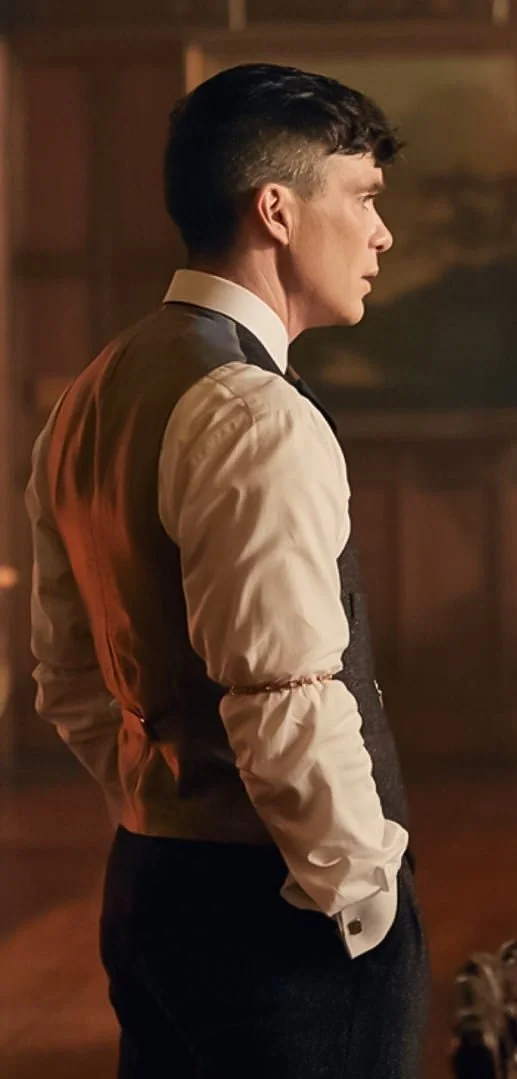

Waistband clip or belt adjustment clip/buttons
Three different ways of tightening the waistband of a pair of pants or a skirt. You're not going to get more than an inch or so tighter without weird bunching, and for most of these you'd want them to be hidden under a shirt or jacket, but they do the job if that's something you're having issues with.
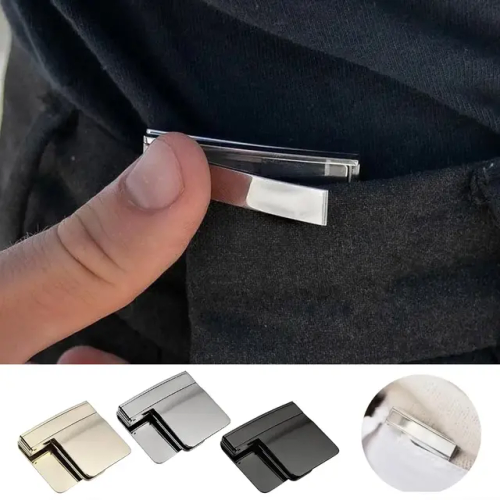


Collar pins: There are so many fun ones out there, both with and without chains. They're not terribly practical, though the slight weight may help keep your collar where you want it. Also consider collar tips, which pin (surprise) to the very tips of your collar points.


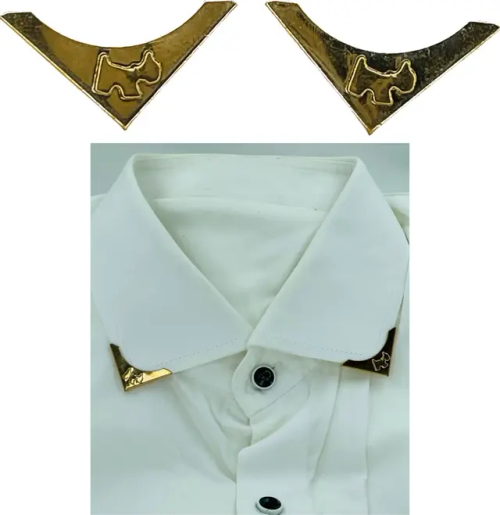
Sweater clips/guards: meant to hold your sweater or cardigan mostly closed. Great if your cardigan doesn't button, or if you don't like it to be buttoned all the way.
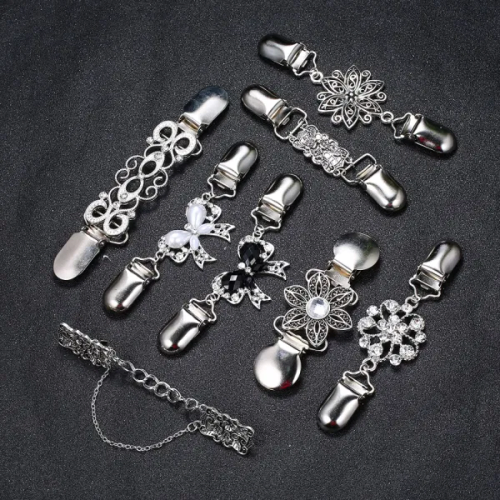
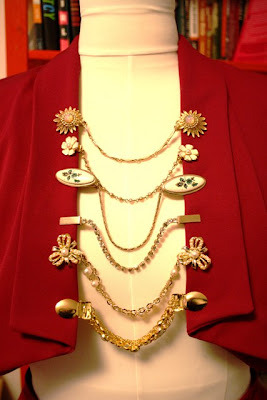
There's tons of other stuff out there like this--etsy is a great place to find this stuff. A lot of these are old solutions to the very modern problem of mass-maufactured clothes not being as one-size-fits-all as advertised, but they're also a fun way to put a bit of personality into businesswear.
In the wake of the TikTok ban and revival as a mouthpiece for fascist propaganda, as well as the downfall of Twitter and Facebook/Facebook-owned platforms to the same evils, I think now is a better time than ever to say LEARN HTML!!! FREE YOURSELVES FROM THE SHACKLES OF MAJOR SOCIAL MEDIA PLATFORMS AND EMBRACE THE INDIE WEB!!!
You can host a website on Neocities for free as long as it's under 1GB (which is a LOT more than it sounds like let me tell you) but if that's not enough you can get 50GB of space (and a variety of other perks) for only $5 a month.

And if you can't/don't want to pay for the extra space, sites like File Garden and Catbox let you host files for free that you can easily link into NeoCities pages (I do this to host videos on mine!) (It also lets you share files NeoCities wouldn't let you upload for free anyways, this is how I upload the .zip files for my 3DS themes on my site.)

Don't know how to write HTML/CSS? No problem. W3schools is an invaluable resource with free lessons on HTML, CSS, JavaScript, PHP, and a whole slew of other programming languages, both for web development and otherwise.

Want a more traditional social media experience? SpaceHey is a platform that mimics the experience of 2000s MySpace

Struggling to find independent web pages that cater to your interests via major search engines? I've got you covered. Marginalia and Wiby are search engines that specifically prioritize non-commercial content. Marginalia also has filters that let you search for more specific categories of website, like wikis, blogs, academia, forums, and vintage sites.
Maybe you wanna log off the modern internet landscape altogether and step back into the pre-social media web altogether, well, Protoweb lets you do just that. It's a proxy service for older browsers (or really just any browser that supports HTTP, but that's mostly old browsers now anyways) that lets you visit restored snapshots of vintage websites.

Protoweb has a lot of Geocities content archived, but if you're interested in that you can find even more old Geocities sites over on the Geocities Gallery
And really this is just general tip-of-the-iceberg stuff. If you dig a little deeper you can find loads more interesting stuff out there. The internet doesn't have to be a miserable place full of nothing but doomposting and targeted ads. The first step to making it less miserable is for YOU, yes YOU, to quit spending all your time on it looking at the handful of miserable websites big tech wants you to spend all your time on.
-
 awfuckward liked this · 1 week ago
awfuckward liked this · 1 week ago -
 chickencat8 liked this · 1 week ago
chickencat8 liked this · 1 week ago -
 holydearlyloved liked this · 2 weeks ago
holydearlyloved liked this · 2 weeks ago -
 carouselingcircus liked this · 2 weeks ago
carouselingcircus liked this · 2 weeks ago -
 tenthmuseondine liked this · 3 weeks ago
tenthmuseondine liked this · 3 weeks ago -
 honeycombscereal reblogged this · 3 weeks ago
honeycombscereal reblogged this · 3 weeks ago -
 cybercybertron liked this · 3 weeks ago
cybercybertron liked this · 3 weeks ago -
 cybercybertron reblogged this · 3 weeks ago
cybercybertron reblogged this · 3 weeks ago -
 a-thousand-wasps-in-a-trenchcoat reblogged this · 3 weeks ago
a-thousand-wasps-in-a-trenchcoat reblogged this · 3 weeks ago -
 a-thousand-wasps-in-a-trenchcoat liked this · 3 weeks ago
a-thousand-wasps-in-a-trenchcoat liked this · 3 weeks ago -
 ashlinsparrow liked this · 3 weeks ago
ashlinsparrow liked this · 3 weeks ago -
 kv94456-blog liked this · 3 weeks ago
kv94456-blog liked this · 3 weeks ago -
 ratalien liked this · 4 weeks ago
ratalien liked this · 4 weeks ago -
 palustrine liked this · 4 weeks ago
palustrine liked this · 4 weeks ago -
 honeymon8 liked this · 4 weeks ago
honeymon8 liked this · 4 weeks ago -
 greenytoons liked this · 4 weeks ago
greenytoons liked this · 4 weeks ago -
 sarcoptid liked this · 4 weeks ago
sarcoptid liked this · 4 weeks ago -
 astremistry liked this · 1 month ago
astremistry liked this · 1 month ago -
 milk1wive liked this · 1 month ago
milk1wive liked this · 1 month ago -
 can-i-explode-now reblogged this · 1 month ago
can-i-explode-now reblogged this · 1 month ago -
 can-i-explode-now liked this · 1 month ago
can-i-explode-now liked this · 1 month ago -
 voidy-lux liked this · 1 month ago
voidy-lux liked this · 1 month ago -
 imaloregremlin reblogged this · 1 month ago
imaloregremlin reblogged this · 1 month ago -
 voidizhere liked this · 1 month ago
voidizhere liked this · 1 month ago -
 avidfireflycatcher liked this · 1 month ago
avidfireflycatcher liked this · 1 month ago -
 icarus-ornithoptery liked this · 1 month ago
icarus-ornithoptery liked this · 1 month ago -
 izzy-mizzie-boo liked this · 1 month ago
izzy-mizzie-boo liked this · 1 month ago -
 artistraccoon reblogged this · 1 month ago
artistraccoon reblogged this · 1 month ago -
 felinae-felidae liked this · 1 month ago
felinae-felidae liked this · 1 month ago -
 zeroshine liked this · 1 month ago
zeroshine liked this · 1 month ago -
 cao-the-dreamer reblogged this · 1 month ago
cao-the-dreamer reblogged this · 1 month ago -
 cao-the-dreamer liked this · 1 month ago
cao-the-dreamer liked this · 1 month ago -
 firebunnylover reblogged this · 1 month ago
firebunnylover reblogged this · 1 month ago -
 firebunnylover liked this · 1 month ago
firebunnylover liked this · 1 month ago -
 tessaigaa reblogged this · 1 month ago
tessaigaa reblogged this · 1 month ago -
 thefrostedmain liked this · 1 month ago
thefrostedmain liked this · 1 month ago -
 somemellowfellow liked this · 1 month ago
somemellowfellow liked this · 1 month ago -
 pastiche-punk liked this · 1 month ago
pastiche-punk liked this · 1 month ago -
 turnaboutdick liked this · 1 month ago
turnaboutdick liked this · 1 month ago -
 thesmellofdustafterrain42 liked this · 1 month ago
thesmellofdustafterrain42 liked this · 1 month ago -
 gold-iridescent liked this · 1 month ago
gold-iridescent liked this · 1 month ago -
 thetraumatizedraccoons reblogged this · 1 month ago
thetraumatizedraccoons reblogged this · 1 month ago -
 noxernia reblogged this · 1 month ago
noxernia reblogged this · 1 month ago -
 thecoffeecrew404 liked this · 1 month ago
thecoffeecrew404 liked this · 1 month ago -
 angelbunni666 liked this · 1 month ago
angelbunni666 liked this · 1 month ago -
 starloveshamburgers liked this · 1 month ago
starloveshamburgers liked this · 1 month ago -
 manwhoisverycool reblogged this · 1 month ago
manwhoisverycool reblogged this · 1 month ago
